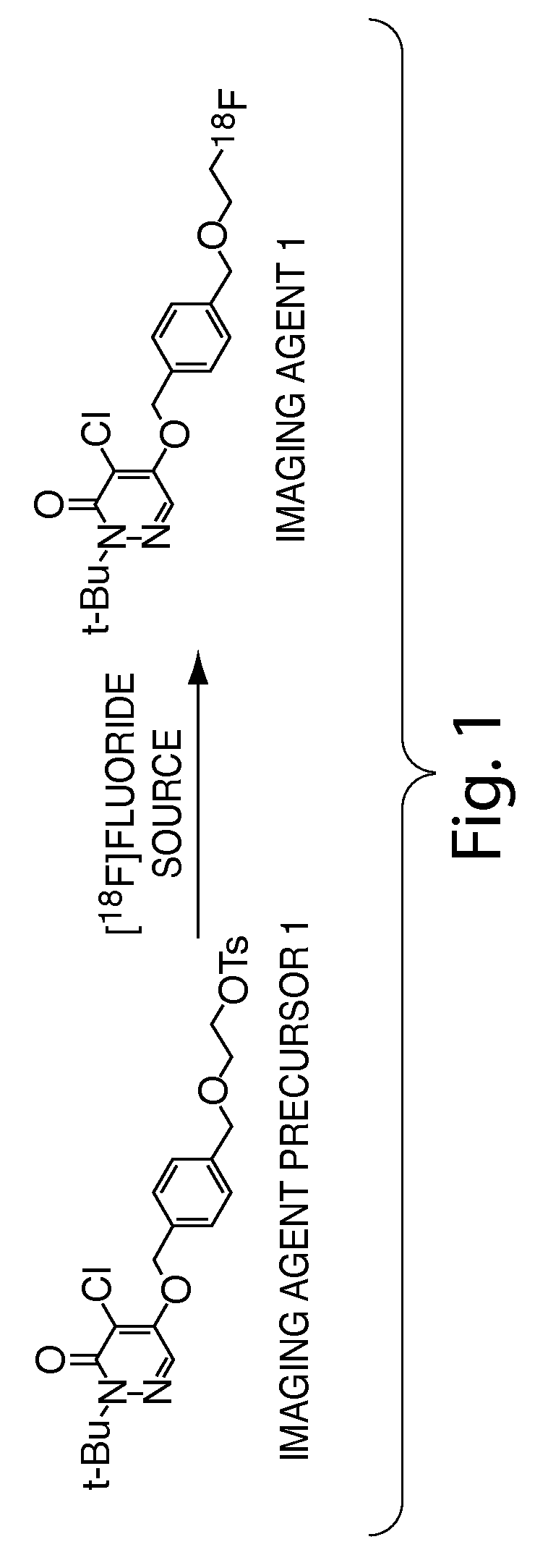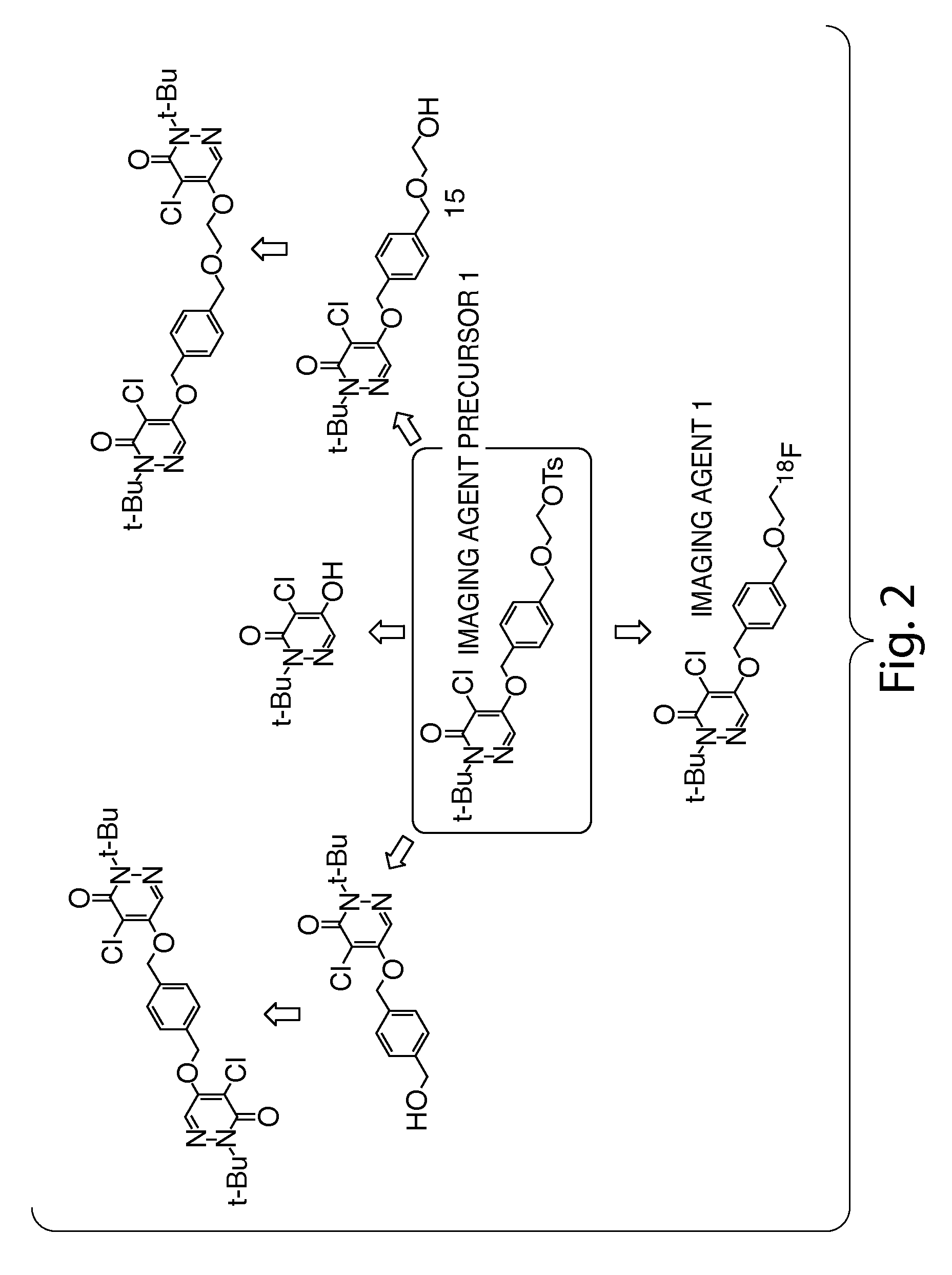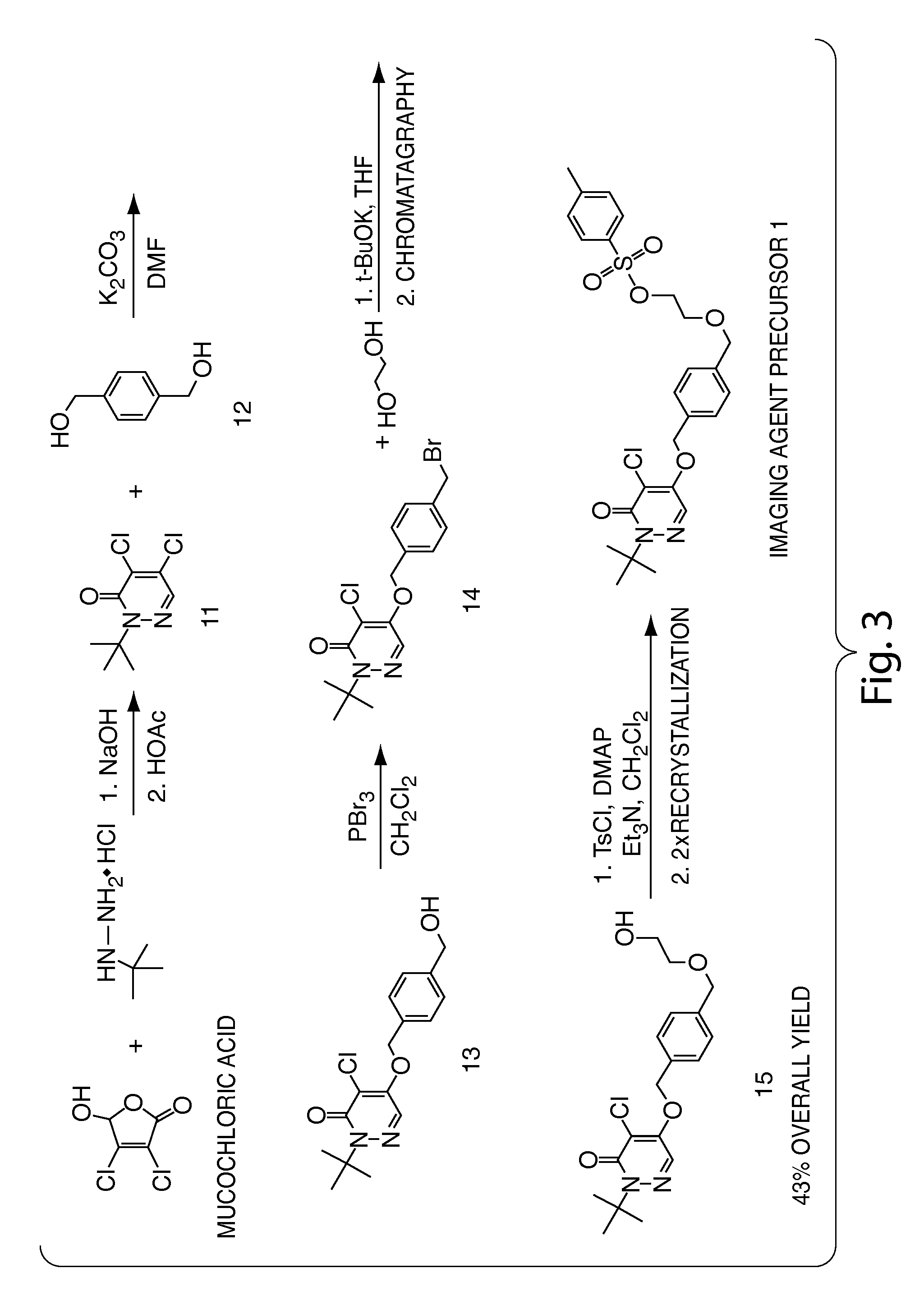Methods and apparatus for synthesizing imaging agents, and intermediates thereof
a technology of imaging agent and synthesizer, which is applied in the field of system, composition, method and apparatus for synthesizing imaging agent, can solve the problems of high cost of the generator, limited clinical use of pet mpi, and limited use of previously available pet myocardial perfusion tracers
- Summary
- Abstract
- Description
- Claims
- Application Information
AI Technical Summary
Benefits of technology
Problems solved by technology
Method used
Image
Examples
example 1
Synthesis of 4-(2-hydroxyethoxymethyl)benzoic acid methyl ester
[0565]
[0566]To a two-neck round bottom flask, which was equipped with a Dewar condenser, a solution of 4-hydroxymethylbenzoic acid methyl ester (2.50 g, 0.015 mol) in anhydrous dichloromethane (30 mL) was cooled to −10° C. in a salt / ice bath. Ethylene oxide (1.10 mL) was added to the cooled stirring solution dropwise followed by the addition of boron trifluoride etherate (0.51 ml). The reaction mixture was stirred for 45 minutes and then warmed to room temperature for 30 minutes to boil off any excess of ethylene oxide from the reaction mixture. The reaction mixture was then diluted with brine. The aqueous layer was extracted with dichloromethane (3 times). All of the organic layers were combined, dried over Na2SO4, filtered, and concentrated to provide an oil. The crude material was purified using silica gel chromatography (4:1 pentane:ethyl acetate) to provide the desired product (537 mg, 2.56 mmol) in 17% yield. 1H (C...
example 2
Synthesis of 4-[2-(t-butyldimethylsilanyloxy)ethoxymethyl]benzoic acid methyl ester
[0567]
[0568]To a solution of the product of Example 1 (544.5 mg, 2.59 mmol) in anhydrous DMF (26 mL) was added imidazole (264 mg, 3.89 mmol) and TBDMS-Cl (586 mg, 3.89 mmol). The reaction mixture stirred at room temperature overnight and was quenched with water. The aqueous layer was extracted with ethyl acetate (3×). All combined organic layers were dried over Na2SO4, filtered, and concentrated. The crude material was purified using silica gel chromatography (4:1 pentane:ethyl acetate) to provide the desired product (677.5 mg, 2.19 mmol) in 84% yield. 1H (CDCl3 8.01, 600 MHz): δ (2H, d, J=8.3 Hz), 7.42 (2H, d, J=8.4 Hz), 4.63 (2H, s), 3.91 (2H, s), 3.82 (2H, t, J=5.0), 3.58 (2H, t, J=5.1 Hz), 0.91 (9H, s), 0.07 (6H, s); 13C (CDCl3 166.5, 143.5, 129.2, 128.8, 126.5, 72.1, 71.6, 150 MHz): δ 62.3, 51.5, 25.4, 17.9, −5.8.
example 3
Synthesis of {4-[2-(t-butyldimethylsilanyloxy)ethoxymethyl]phenyl}methanol
[0569]
[0570]To a solution of the product of Example 2 (670 mg, 2.18 mmol) dissolved in anhydrous THF (22 mL) was added a solution of LAH (1.0 M solution in THF, 2.18 mL, 2.18 mmol) dropwise. After completion of addition the reaction mixture was stirred at room temperature for 3 hours. The reaction mixture was diluted with water. The aqueous layer was extracted with ethyl acetate (3×). All combined organic layers were dried over Na2SO4, filtered, and concentrated to provide an oil (587 mg, 1.98 mmol), which was used in the next step without any further purification (91% yield). 1H (CDCl3 7.34 (4H, s), 4.68 (2H, s), 4.57 (2H, s), 3.80, 600 MHz): δ (2H, t, J=5.2 Hz), 3.56 (2H, t, J=5.3 Hz), 1.69 (1H, br s), 0.90 (9H, s), 0.07 (6H, s); 13C (CDCl3 140.4, 138.3, 128.0, 127.2, 73.2, 71.9, 65.4, 150 MHz): δ 63.0, 26.2, 18.6, −5.0.
PUM
| Property | Measurement | Unit |
|---|---|---|
| temperature | aaaaa | aaaaa |
| temperature | aaaaa | aaaaa |
| temperature | aaaaa | aaaaa |
Abstract
Description
Claims
Application Information
 Login to View More
Login to View More - R&D
- Intellectual Property
- Life Sciences
- Materials
- Tech Scout
- Unparalleled Data Quality
- Higher Quality Content
- 60% Fewer Hallucinations
Browse by: Latest US Patents, China's latest patents, Technical Efficacy Thesaurus, Application Domain, Technology Topic, Popular Technical Reports.
© 2025 PatSnap. All rights reserved.Legal|Privacy policy|Modern Slavery Act Transparency Statement|Sitemap|About US| Contact US: help@patsnap.com



